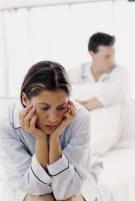
An Often Under Managed ProblemSexuality is a complex process and behavior.
It is coordinated not only by various systems of our bodies such as the endocrine, nervous, vascular and others.
It is also related to personal experience, social, cultural beliefs, and changes with age. Sexuality is also much affected by interpersonal relationships or lack thereof. Each partner brings different needs and response to the sexual relationship. Any disturbance in any of these areas can potentially lead to sexual dysfunction.
For centuries, in many old cultures as well as new cultures, the society tends to focus on the needs and the problems of male sexual dysfunction. During the last 40 years in the West, feminine rights, liberation and sexuality have gone through dramatic changes.
For centuries, in many old cultures as well as new cultures, the society tends to focus on the needs and the problems of male sexual dysfunction. During the last 40 years in the West, feminine rights, liberation and sexuality have gone through dramatic changes.
Coupled with increased aging and menopause of American female baby boomers, prevalence of female sexual dysfunction complaints, awareness has surged.
The creation of Viagra was immediately followed by intense pharmaceutical inquiry into a female version of Viagra.
The popular press has now spent much of their efforts in educating the public about Female Sexual Dysfunction (FSD).
These sexual problems are not new. In fact, thousands of years ago, Taoists in China believed that a healthy sexual life style could lead to good health and minimize illness. Some Taoists even believe that cultivating great sexual health and habits can lead to longevity and immortality.
The famous Taoist text, "The Tao of Sex" is one of the earliest texts in the world addressing issues of sexuality ranging from specific sexual positions to usage of herbs for sexual dysfunctions.
There are four areas of Female Sexual Dysfunction desire, arousal, orgasmic, and pain disorders.
They frequently overlap and need to be ascertained properly. Many medical conditions are a source of direct or indirect sexual problems.
Diabetes, incontinence, arthritis, cardiovascular disease, and mood disorders are just some the conditions that may disturb normal sexuality.
Medications such as antidepressants and antihypertensives can suppress sexual desire.
Gynecologic conditions can also contribute to sexual difficulties. For example, chronic recurrent bladder infection can diminish desire. Chronic vaginal or cervical infections can make sexual intercourse less desirable. Normal progression through menopause can also exhibit vaginal dryness and decreased libido. Psychological conditions from past sexual molestation and rape can create physical problems. Current relationship problems can also dampen desire and arousal.
Chinese Medicine offers many tools for addressing these issues. Acupuncture, which has proven neurological and endocrinal effects, can be used in vaginismus-a condition where the outer vaginal muscle contracts to prevent entering of any foreign objects. It is also frequently used in sexual pains especially due to endometriosis, and chronic bladder infection. Acupuncture can also relax one's mood, enhance sensuality and arousal. Herbal medicine is frequently used in combination or alone, especially for hormone regulation. It can also be used in chronic bladder infections associated with sex. Herbs are frequently stimulating to the sex drive as well.
The key to good sexual health is to eradicate problems right away when they arise. Inform your gynecologist and your Tao of Wellness practitioners if you feel you might suffer from these issues.
The key to good sexual health is to eradicate problems right away when they arise. Inform your gynecologist and your Tao of Wellness practitioners if you feel you might suffer from these issues.






